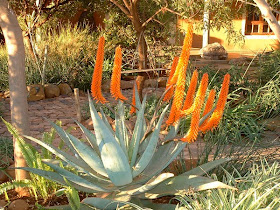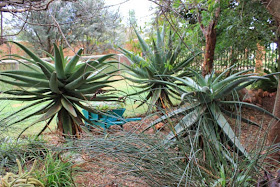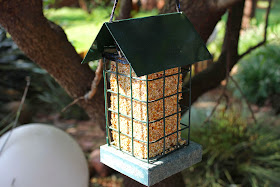🍄 The bliss of gardening on my little piece of African soil. A year-by-year record of the progress in my old garden. My "new" garden of 2000sq.m. started in 2004, and ended when we sold our smallholding in 2017and moved to the Dolphin Coast in KwaZulu Natal. Now "my garden" consists of a postage-stamp-size mostly-indigenous succulent garden and it always amazes me how supposedly drought-resistant plants do so well in this tropical coastal region.
Pages
▼
Saturday, 26 July 2014
Epsom salts in the garden and home
We've had a couple of warm days, but last night another cold front moved in, dropping temperatures to below freezing again. I've been checking on my potted Echeverias, moving them from under cover to protected sunny spots in the garden and hope this cold spell doesn't adversely affect them. Most of the beds have been cleared of debris and dead plants, ready to take on spring's Marigolds and Nasturtiums that will be showing their little faces again.
With nothing much better to do, I've been going through my files, trying to find ways and means of giving my plants a boost in spring, and remembered about Epsom Salts, so here's a few tips for the garden and in your home.
Composed almost exclusively of Magnesium Sulfate, Epsom salt is intensely rich in these two minerals that are both crucial to healthy plant life, a stronger root structure and to facilitate the uptake of chlorophyll.
Magnesium is beneficial to plants from the beginning of their life, right when the seed begins to develop. It assists with the process of seed germination; infusing the seed with this important mineral and helping to strengthen the plant cell walls, so that the plant can receive essential nutrients. Magnesium also plays a crucial role in photosynthesis by assisting with the creation of chlorophyll, used by plants to convert sunlight into food. In addition, it is a wonderful help in allowing the plant to soak up phosphorus and nitrogen, which serve as vital fertilizer components for the soil. Magnesium is believed to bring more flowers and fruit to your garden, increasing the bounty as well as the beauty of your space.
For potted plants, simply dissolve 2 tablespoons per gallon of water, and substitute this solution for normal watering at least once a month – although it is safe to do this as often as desired. Epsom salts help to clear up this accumulation of natural salts in the pot, and lead to a revival in the plant's health and vibrancy.
Garden startup
Sprinkle approximately one cup per 100 square feet. (10’x10’) and mix into soil before planting. It is also a natural pesticide for snails and slugs.
Roses
Add a tablespoon a week to the soil around rose bushes before watering for faster growth.
I myself have been using Epsom salts in my home for many years. As a relaxing bath soak I add at least 1 cup of epsom salt to a warm bath and soak for 20 minutes. This also helps for sunburn, which I used to suffer from a lot in earlier years (no more!)
After a hard day's work in the garden, I add 2 cups of epsom salt to a warm bath and soak for at least 20 minutes to help relieve muscle aches and pains. It is wonderful for aching feet, just add 1 cup of epsom salt to hot water in your foot spa and soak for 10-20 minutes.
When we were children, we had to take a teaspoon of Epsom salts every Friday night as a general laxative. My father believed it cleaned out the system and got rid of unwanted toxins. It's a habit I continue to this day.
.
Tuesday, 22 July 2014
Autumn and Winter is Aloe time
Africa loves to paint her winter landscape in orange and yellow hues, and her exuberance is infectious. Nothing beautifies the winter garden like the bright splashes of colour supplied by Aloes. Every winter I'm blessed with the beauty of these flowers, but this winter has been very extreme and I've only got one flowering, on the other two the flowers got caught by the frost just as they were emerging.
The Cape Aloe (Aloe ferox) is known as one of the most potent healing plants known to man. This uniquely South African Aloe grows naturally in semi-dessert conditions on the hills of the Eastern Cape.
It is a distinctly handsome plant, with broad, lance-shaped, fleshy leaves with spines on the edge. In its natural habitat or in the frost-free garden it can attain great size, 2 to 3 meters in height with the leaves arranged in a rosette. They are often grown indoors where they can thrive in consistently warm temperatures. The leaves vary, sometimes with a slightly blue look or a reddish tinge and sometimes they appear spotted.
The flowers are carried in a large candelabra-like flower-head. There are usually between five and eight branches, each carrying a spike-like head of many flowers. Flower colour varies from yellowy-orange to bright red and occurs between May and August, but in colder parts this may be delayed until September.
Two of my aloes in full flower last winter
Aloe ferox in summer
People get Aloe Ferox confused with Aloe Vera - Vera products are made of Aloe found in America, whereas the Ferox grows indigenously in South Africa. Aloe ferox has more vitamins, minerals, amino acids and polysaccharides than Aloe Vera. Aloe Ferox contains two principle ingredients: Aloe gel, the white inner fleshy part of the leaf and Aloe bitters, which are not readily available from Aloe Vera. Aloe gel drains from the leaf of the plant when cut. It is well known for its superior antiseptic, cleansing, moisturizing and anti-inflammatory properties. The dark sap comes from between the green peel and the white jelly of the leaf. The “bitters” or "Schwedenbitters" are used for their laxative qualities and to treat arthritis.
After flowering, the flower stalks are covered in seeds. These can be collected and dried, ready to be planted in pots or somewhere in the garden. The seeds also disperse naturally and you will find many pups appearing all over your garden. Be aware that aloes will hybridise with any other aloe flowering at the same time. I have quite a few "unknown" aloes in my garden because of this hybridisation.
Aloe ferox pups growing from seeds dispersed by the wind or birds. These are now ready to be transplanted, will find a nice, sunny spot for them in spring.
Sowing:
Sow indoors at any time of year. Fill small pots or trays with a light and well drained compost. Stand the pots in water, moisten thoroughly and drain. Scatter the seed onto the top of the compost and cover lightly with sand. Care should be taken to prevent the pots drying out.
The majority of seeds germinate at temperatures of 22 to 24°C (70 to 75°F). Some seedlings may appear at around 30 days others will take longer, up to 180 days.
Once germination has taken place, move into a good light. Be careful to keep the top of the compost damp but watch out for overwatering as the seedlings could rot. Transplant into pots once they are about 4cm high (6 months). Always use a pot with a hole and put a layer of small gravel at the bottom of the pot and also one inch on the top of the soil to prevent stem rot.
Transplanting:
Aloes have a shallow, spreading root system, so when it is time to repot choose a wide planter, rather than a deep one. Use a planter with a drainage hole, or provide a 3 to 5cm (1 to 2in) layer of gravel in the bottom of the pot to ensure adequate drainage. Use a good commercial potting mix with extra perlite, granite grit, or coarse sand added. You may also use a packaged 'cacti mix' soil.
Cultivation:
During the winter months, the plant will become dormant, and utilise very little moisture. During this period watering should be minimal. Allow the soil to become completely dry before giving the plant warm water. During the summer months, the soil should be completely soaked, but then be allowed to dry again before re-watering. If you use rainwater, be careful as it could be acidic.
Fertilise yearly, in the spring with a dilute (½ strength), bloom fertilizer (10-40-10). Aloes are easily grown from seeds, but also can be propagated by removing the offsets produced around the base of mature plants, when they are a couple inches tall.
Medicinal Uses:
Aloe effectively regenerates injured nerves and new skin cells. It is commonly used to soothe burns, including sunburn and radiation burns. Aloe is also applied to wounds, insect bites, eczema, ringworm, rashes, leg ulcerations and severe acne. It is also used to reduce the pain and swelling of arthritis and rheumatism. Aloe is also used to treat headache, dizziness, constipation and insomnia. Aloe gel is perishable. Freeze the fresh gel in small blocks and defrost before use.
There are more than 450 species of aloe plants, varying in size from diminutive pot plants to large clumps. They inhabit dry, often rocky and exposed areas.
There is an ongoing debate as to whether aloes and their close relatives should be placed in the family Asphodelaceae, Liliaceae, or Aloaceae.
::
Friday, 18 July 2014
Aloes sharing space
Aloes sharing space with Marigolds and two Cocos plumosa palm trees at the beginning of this winter (2014) in my garden.
.
Sunday, 13 July 2014
Remember the birds in winter
One of the joys of having a garden, is the amount of wildlife it draws. Birds, lizards, insects, hedgehogs, butterflies, bees, the list is endless.
In winter the wild birds can have a hard time finding enough food. As winter approaches, many birds change some of their eating habits. Birds that usually eat insects may start to eat berries or fruit to supplement their diets. Birds will start to look for reliable sources of food for wintertime survival. Turn your garden into a haven which they will frequently visit for something to eat and drink. Feeding the birds is a rewarding and enjoyable hobby in the midst of chilly winter weather.
To attract the greatest number of species in the winter, it is important to have a number of different birdfeeders available, Ideally, winter birdfeeders should be placed in sheltered locations out of the most severe winds. Placing feeders closer to the house will be effective and will help keep the birds visible for indoor bird watching. At the same time, feeders should be placed near protective cover such as hedges or trees to offer birds safety from predators.
In winter, I put out food and water on a regular basis. In severe weather, I feed twice daily: in the morning and in the early afternoon. During summer I cut down to once daily, in the morning, with a good mix of Black sunflower seeds, pinhead oatmeal, soaked sultanas, raisins and currants, mild grated cheese, mealworms, mixes for insectivorous birds and good seed mixtures. Soft apples and pears cut in half, bananas and grapes are also good. Some people use soaked dog or cat food and tinned pet foods, but these may attract rats, crows and cats. Avoid using peanuts, fat and bread in summer, since these can be harmful if adult birds feed them to their nestlings.
Fill a pine cone with peanut butter and then roll it in some bird seed. Tie your pine cone to a tree with a piece of string or wire and soon you will have dozens of new feathered friends flocking into your garden for this lovely snack.
A quick, easy and inexpensive way to cater for the fruit eaters is to bend a wire coat hanger into a heart-shape. Add another piece of soft, pliable wire to the top of the hanger onto which to attach the apple, hang in a tree and voila! bob's your uncle! The Black-headed Orioles regularly visit to enjoy the fruit I put out.
This is the scene that greets me most mornings when I go out to fill the feeders and feeding tables. This crowd is a mix of Buntings, Larks, Canaries, Weavers, Laughing Doves and possibly a few Queleas as well.
Laughing Doves, patiently waiting, etched against the cold, blue sky
Weavers waiting for me to finish, enjoying the sun in the bare peach tree
As soon as I turn my back after filling all the various feeders, everybody swarms down to see what is on offer!
A feeder that can do double duty as a seed bowl or a water dish
A seed cage keeps waste to the minimum
A Cape Robin enjoying some of the fruit on offer.
Experts disagree about whether backyard bird feeding will significantly help bird populations. But feeding certainly can help individual birds in your neighbourhood.
And don't worry if you must stop feeding briefly—while going on holiday, for example. In all but the most severe weather conditions, wild birds will find other food in your absence, particularly in suburban areas where other birdfeeders are just a short flight away. If you live in a rural or isolated area, however, try to arrange to have a neighbor maintain the feeders during winter absences.
.
Thursday, 10 July 2014
The outside room
As I look out to my garden
I feel a sense of pride
It really is a lovely room
Except it is outside!
~ unknown
This area is fairly well protected from the cold, surrounded by high walls, but the frost does still get to the Sword Ferns. Luckily they spring back in all their glory again in spring. I've brought the Pachy and the Echeverias in the pots inside for the winter, but the basket is much too heavy to try and move. Besides which I don't have the space for it, unless I put it in the bath!
Looking from the garden into the bathroom
Looking from the bathroom into the garden
Looking from the bathroom into the garden
::
.
Tuesday, 8 July 2014
Winter takes its toll
It certainly has been cold this winter, but Monday the weather took an extreme turn with temperatures plummeting to -5℃ last night. Three days ago, my Arum lilies (above) were still in fairly good condition, but this morning, to my utter dismay, they were flat on the ground, wilted and broken (below). It looks like something has ploughed right over them but, no, it's only the cold! I made the mistake of watering them on Monday, thinking of their natural habitat in the Cape where they get winter rainfall, not taking into account that they don't get the frost that we do!
The Sword ferns are also worse for the wear, except those that are under the protection of a Black Karee tree, which has sheltered them from the severe frost.
Saved by the over-hanging canopy of the Black Karee!
The colourful walkway of last summer now stark and bare
This Hydrangea is just a couple of dried-up sticks, yet new buds are already peeping through!
The Nasturtiums that flowered right through last winter have succumbed to this year's cold
The Zebra grass, dry and colourless. I don't cut them down until just before spring as the chickens love hiding from the cold wind between them and luckily they jump right back to life as soon as it warms up again.
More dead Zebra grass with my Cycad in the back-ground. Luckily he is also afforded some protection by the White Stinkwood.
Echeveria glauca in a wheelbarrow, too big to bring inside, showing the effects of the cold. I'm just hoping and praying the cold won't get any worse...
.
My garden - Frosty-white and cold it lies .
Underneath the fretful skies;
Though the winds are keen and chill
Roses' hearts are beating still,
And the garden tranquilly
Dreams of happy hours to be
In the summer days of blue
All its dreamings will come true.
.





















































